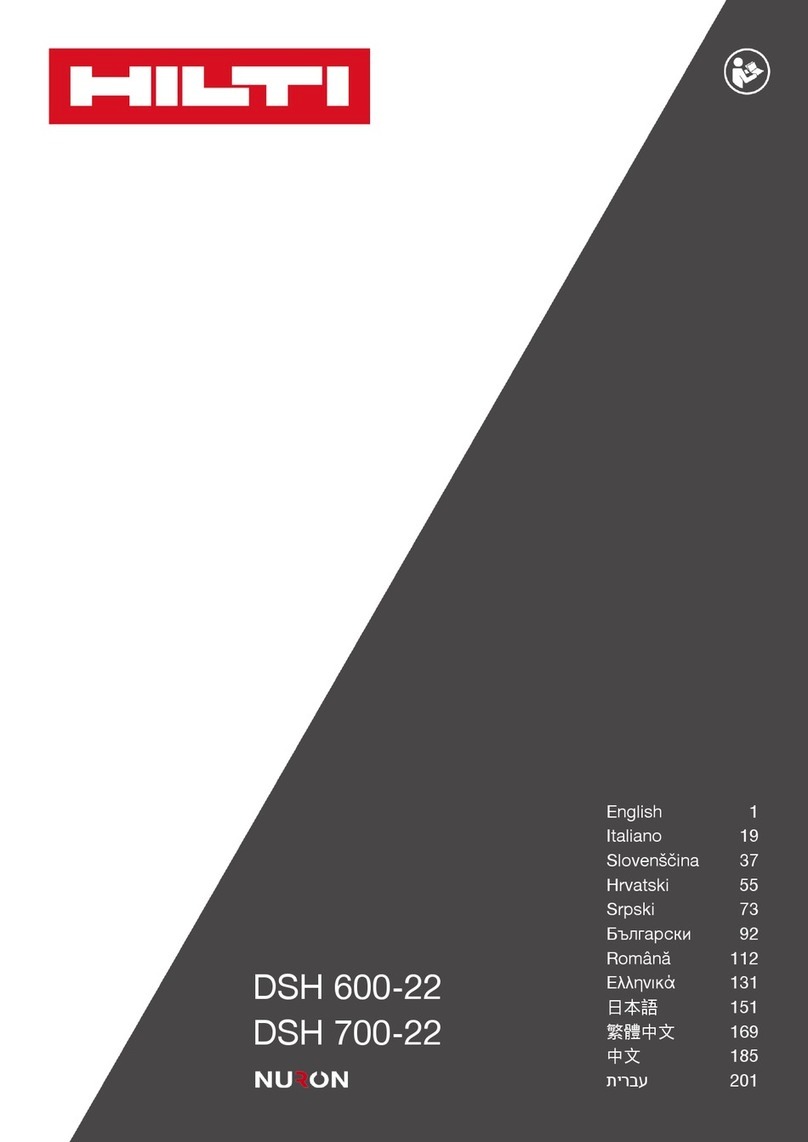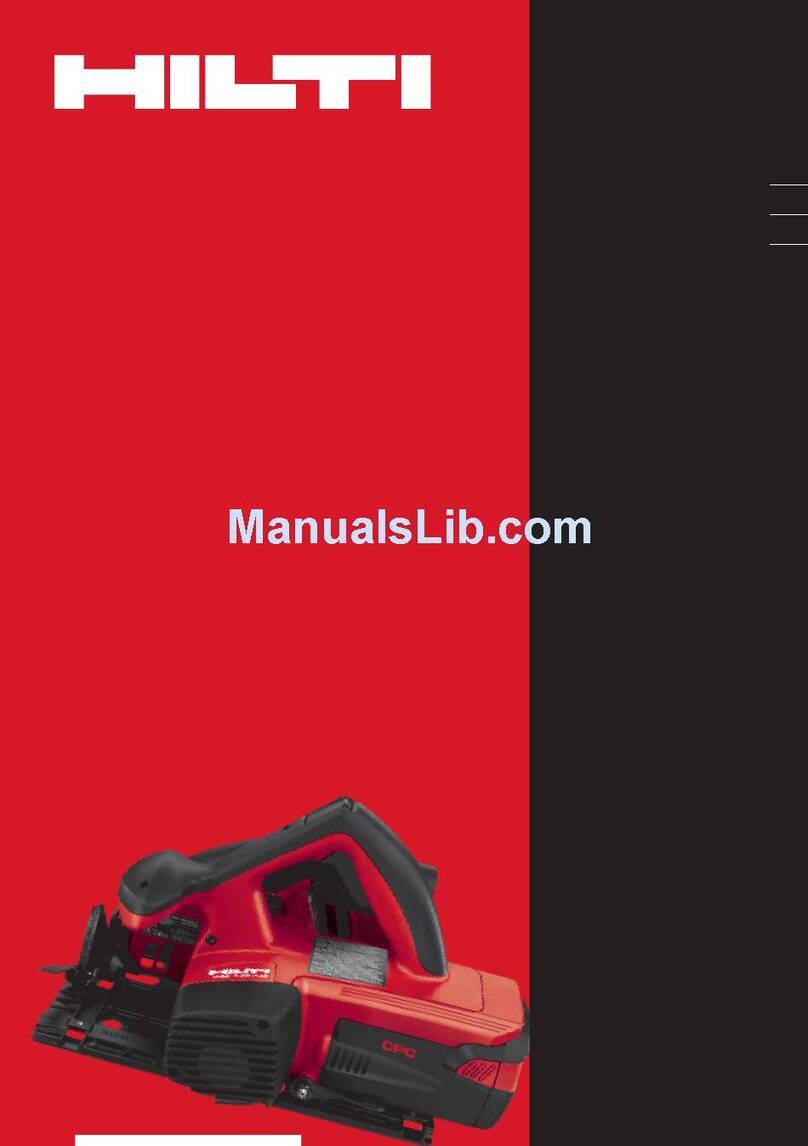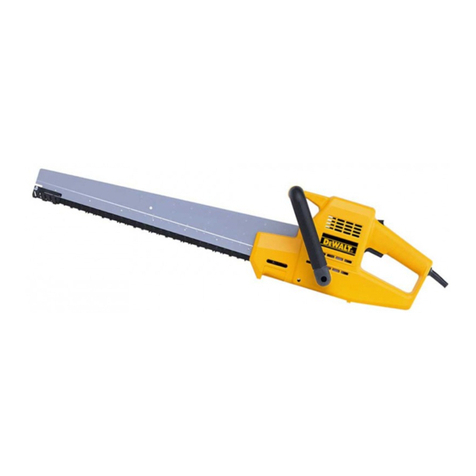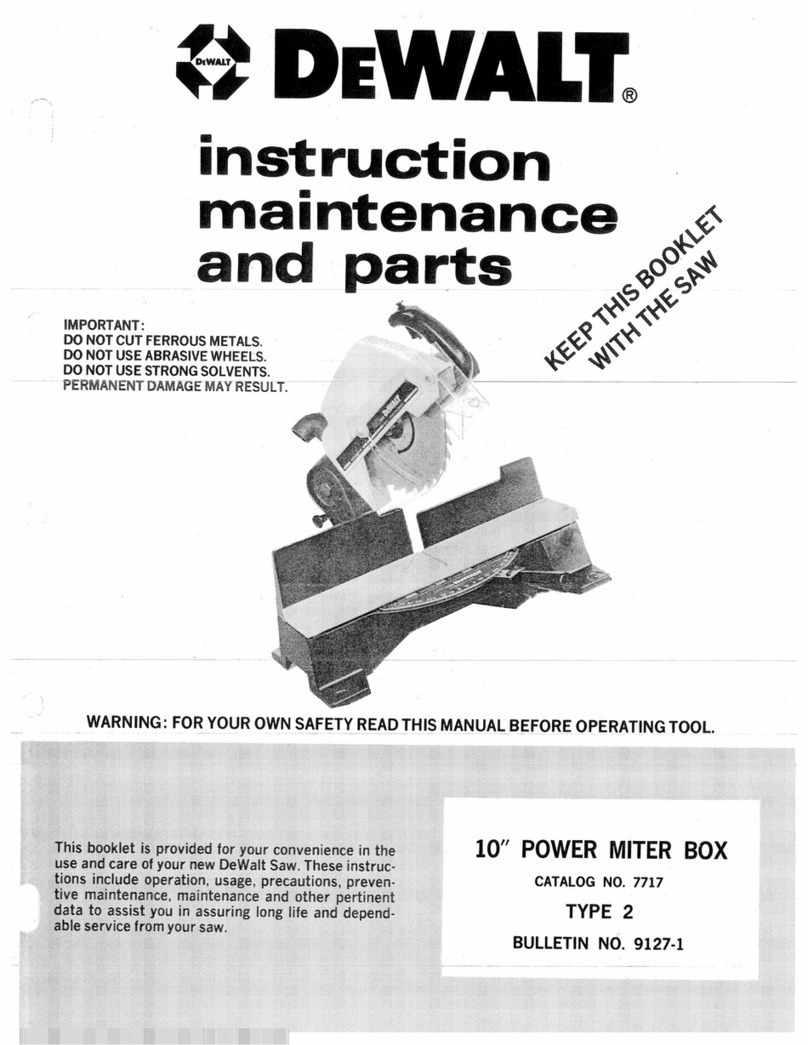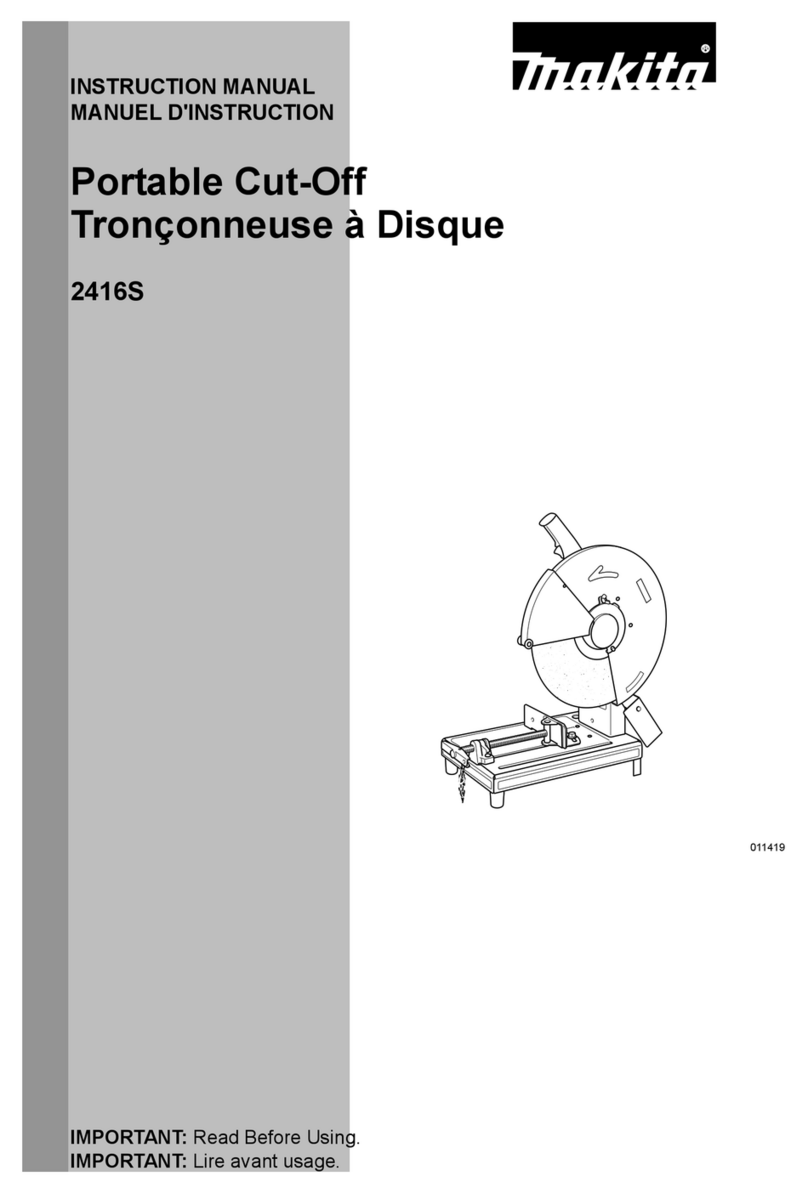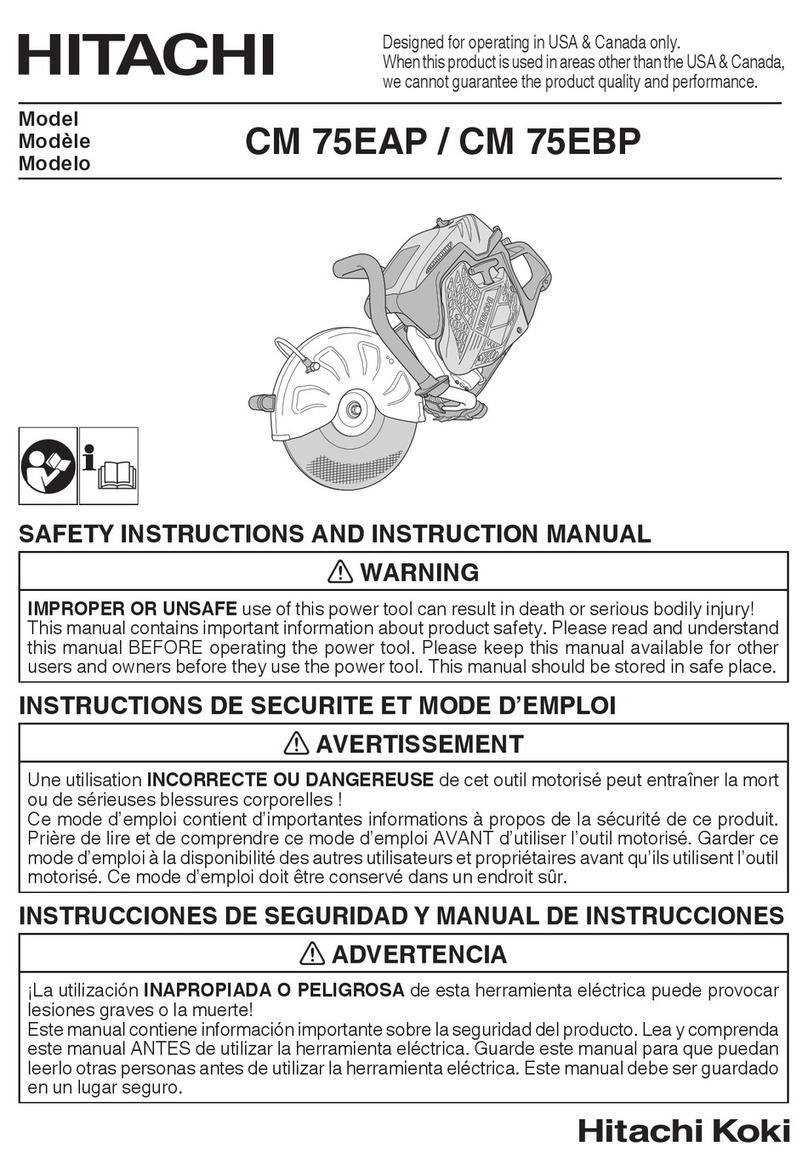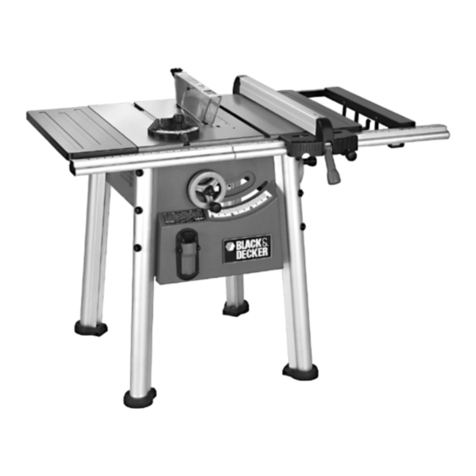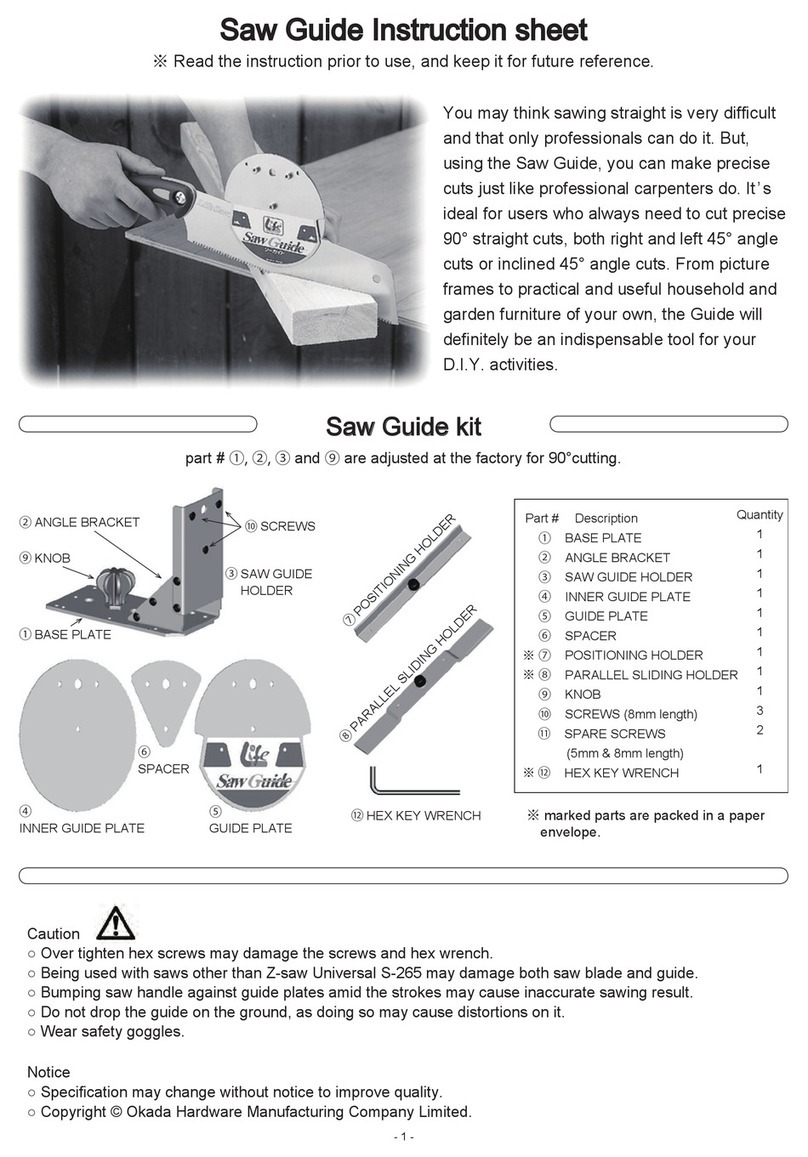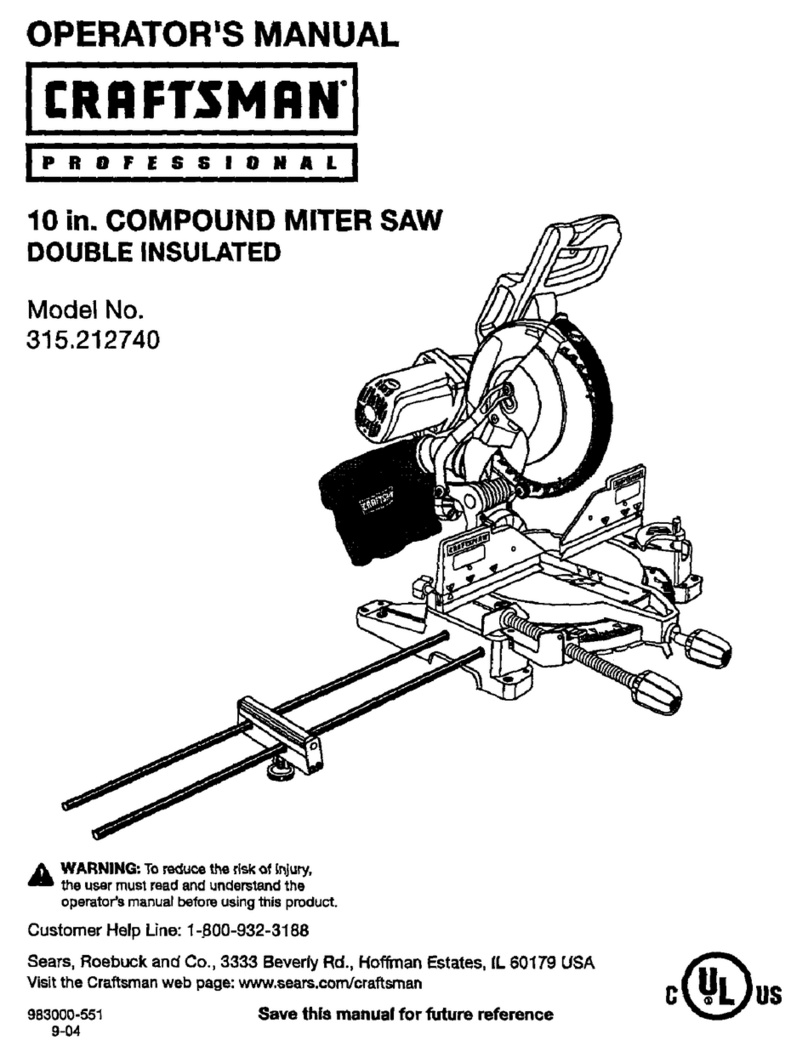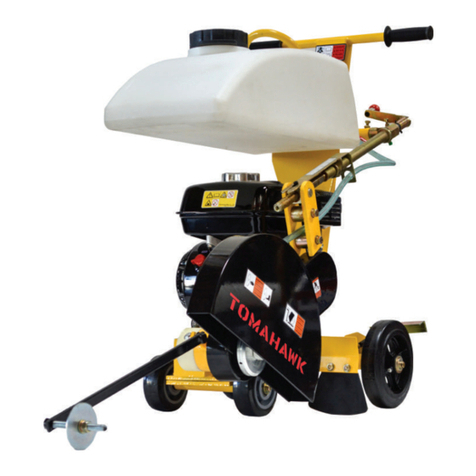Hilti WSC 7.25-S User manual

WSC 7.25-S
Operating instructions en
Mode d’emploi fr
Manual de instrucciones es
Printed: 07.07.2013 | Doc-Nr: PUB / 5071328 / 000 / 00

This Product is Certified
Ce produit est certifié
Este producto esta certificado
Este produto está certificado
CUS
Printed: 07.07.2013 | Doc-Nr: PUB / 5071328 / 000 / 00

1
en
It is essential that the operating instructions
are read before the tool is operated for the
first time.
Always keep these operating instructions
together with the tool.
Ensure that the operating instructions
are with the tool when it is given to other
persons.
ORIGINAL OPERATING INSTRUCTIONS
Circular Saw WSC 7.25-S
Contents Page
1. Specifications 1
2. General Power Tool Safety Warnings 1
3. Safety Instructions for all saws 2
4. Further Safety Instructions for all saws 3
5. Safety Instructions for Saws with Pendulum
Guard 4
6. Save these Instructions 5
7. Symbols 6
8. Functional Description 6
9. Assembly 7
10. Operation 8
11. Maintenance 9
12. Accessories 10
13. Manufacturer's warranty – tools 10
1. Specifications
Model WSC 7.25-S
Blade diameter 185 mm (7-1/4")
at 0° 62.5 mm (2-7/16")
Max. Cutting depth at 45° 43.5 mm (1-11/16")
at 56° 32.5 mm (1-1/4")
No load speed (RPM) 5,800/min.
Overall length 317 mm (12-1/2")
Net weight 5.2 kg (11-1/2 lbs)
• Due to our continuing program of research and
development, the specifications herein are subject
to change without notice.
• Specifications may differ from country to country.
• Weight according to EPTA-Procedure 01/2003
2. General Power Tool Safety Warnings
WARNING Read all safety warnings and all instruc-
tions. Failure to follow the warnings and instructions
may result in electric shock, fire and/or serious injury.
Save all warnings and instructions for future reference
The term "power tool" in the warnings refers to your
mains-operated (corded) power tool or battery-operat-
ed (cordless) power tool.
2.1 Work area safety
a) Keep work area clean and well lit. Cluttered or dark
areas invite accidents.
b) Do not operate power tools in explosive atmos-
pheres, such as in the presence of flammable liq-
uids, gases or dust. Power tools create sparks which
may ignite the dust or fumes.
c) Keep children and bystanders away while operat-
ingapowertool.Distractions can cause you to lose
control.
2.2 Electrical safety
a) Power tool plugs must match the outlet. Never mod-
ify the plug in any way. Do not use any adapter plugs
with earthed (grounded) power tools. Unmodified
plugs and matching outlets will reduce risk of elec-
tric shock.
b) Avoid body contact with earthed or grounded sur-
faces such as pipes, radiators, ranges and refrig-
erators. There is an increased risk of electric shock
if your body is earthed or grounded.
c) Do not expose power tools to rain or wet conditions.
Water entering a power tool will increase the risk of
electric shock.
Printed: 07.07.2013 | Doc-Nr: PUB / 5071328 / 000 / 00

2
en
d) Do not abuse the cord. Never use the cord for car-
rying, pulling or unplugging the power tool. Keep
cord away from heat, oil, sharp edges or moving
parts. Damaged or entangled cords increase the risk
of electric shock.
e) When operating a power tool outdoors, use an exten-
sion cord suitable for outdoor use. Use of a cord
suitable for outdoor use reduces the risk of electric
shock.
f) If operating a power tool in a damp location is
unavoidable, use a ground fault circuit interrupter
(GFCI) protected supply. Use of a GFCI reduces the
risk of electric shock.
2.3 Personal safety
a) Stay alert, watch what you are doing and use com-
mon sense when operating a power tool. Do not use
a power tool while you are tired or under the influ-
ence of drugs, alcohol or medication. A moment of
inattention while operating power tools may result in
serious personal injury.
b) Use personal protective equipment. Always wear
eye protection. Protective equipment such as dust
mask, non-skid safety shoes, hard hat, or hearing
protection used for appropriate conditions will reduce
personal injuries.
c) Prevent unintentional starting. Ensure the switch
is in the off-position before connecting to power
source and/or battery pack, picking up or carrying
the tool. Carrying power tools with your finger on the
switch or energising power tools that have the switch
on invites accidents.
d) Remove any adjusting key or wrench before turn-
ing the power tool on. A wrench or a key left attached
to a rotating part of the power tool may result in per-
sonal injury.
e) Do not overreach. Keep proper footing and balance
at all times. This enables better control of the pow-
er tool in unexpected situations.
f) Dress properly. Do not wear loose clothing or jew-
ellery. Keep your hair, clothing, and gloves away
from moving parts. Loose clothes, jewellery or long
hair can be caught in moving parts.
g) If devices are provided for the connection of dust
extraction and collection facilities, ensure these
are connected and properly used. Use of dust col-
lection can reduce dust-related hazards.
2.4 Power tool use and care
a) Do not force the power tool. Use the correct power
tool for your application. The correct power tool will
do the job better and safer at the rate for which it was
designed.
b) Do not use the power tool if the switch does not turn
it on and off. Any power tool that cannot be controlled
with the switch is dangerous and must be repaired.
c) Disconnect the plug from the power source and/or
the battery pack from the power tool before mak-
ing any adjustments, changing accessories, or stor-
ing power tools. Such preventive safety measures
reduce the risk of starting the power tool accidentally.
d) Store idle power tools out of the reach of children
and do not allow persons unfamiliar with the pow-
er tool or these instructions to operate the power
tool. Power tools are dangerous in the hands of
untrained users.
e) Maintain power tools. Check for misalignment or
binding of moving parts, breakage of parts and any
other condition that may affect the power tool’s oper-
ation. If damaged, have the power tool repaired
before use. Many accidents are caused by poorly
maintained power tools.
f) Keep cutting tools sharp and clean. Properly main-
tained cutting tools with sharp cutting edges are less
likely to bind and are easier to control.
g) Use the power tool, accessories and tool bits etc.
in accordance with these instructions, taking into
account the working conditions and the work to be
performed. Use of the power tool for operations dif-
ferent from those intended could result in a hazardous
situation.
2.5 Service
a) Have your power tool serviced by a qualified repair
person using only identical replacement parts. This
will ensure that the safety of the power tool is main-
tained.
3. Safety Instructions for all saws
a) DANGER: Keep hands away from cutting area
and the blade. Keep your second hand on auxiliary
handle, or motor housing. If both hands are holding
the saw, they cannot be cut by the blade.
b) Do not reach underneath the workpiece. The guard
cannot protect you from the blade below the work-
piece.
c) Adjust the cutting depth to the thickness of the work-
piece. Less than a full tooth of the blade teeth should
be visible below the workpiece.
d) Never hold piece being cut in your hands or across
your leg. Secure the workpiece to stable platform.
It is important to support the work properly to mini-
mize body exposure, blade binding, or loss of con-
trol.
Printed: 07.07.2013 | Doc-Nr: PUB / 5071328 / 000 / 00

3
en
4. Further Safety Instructions for all saws
a) Causes and Operator Prevention of Kickback:
− kickback is a sudden reaction to a pinched, bound
or misaligned saw blade, causing an uncontrolled
saw to lift up and out of the workpiece toward the
operator;
− when the blade is pinched or bound tightly by the
kerf closing down, the blade stalls and the motor
reaction drives the unit rapidly back toward the oper-
ator;
− if the blade becomes twisted or misaligned in the
cut, the teeth at the back edge of the blade can dig
into the top surface of the wood causing the blade
to climb out of the kerf and jump back toward the
operator.
Kickback is the result of saw misuse and/or incorrect
operating procedures or conditions and can be avoid-
ed by taking proper precautions as given below:
1. Maintain a firm grip with both hands on the saw
and position your arms to resist kickback forces.
Position your body to either side of the blade, but
not in line with the blade. Kickback could cause
the saw to jump backwards, but kickback forces
can be controlled by the operator, if proper pre-
cautions are taken.
2. When blade is binding, or when interrupting a
cut for any reason, release the trigger and hold
the saw motionless in the material until the blade
comes to a complete stop. Never attempt to remove
the saw from the work or pull the saw backward
while the blade is in motion or kickback may
occur. Investigate and take corrective actions to
eliminate the cause of blade binding.
3. When restarting a saw in the workpiece, centre
the saw blade in the kerf and check that saw teeth
are not engaged into the material. If saw blade is
binding, it may walk up or kickback from the work-
piece as the saw is restarted.
4. Support large panels to minimise the risk of blade
pinching and kickback. Large panels tend to sag
under their own weight. Supports must be placed
under the panel on both sides, near the line of cut
and near the edge of the panel.
To avoid kickback, do support board or panel near the
cut.
Do not support board or panel away from the cut.
A typical illustration of proper hand support, workpiece
support, and supply cord routing (if applicable).
e) Hold power tool by insulated gripping surfaces when
performing an operation where the cutting tool may
contact hidden wiring or its own cord. Contact with
a "live" wire will also make exposed metal parts of the
power tool "live" and shock the operator.
f) When ripping always use a rip fence or straight edge
guide. This improves the accuracy of cut and reduces
the chance of blade binding.
g) Always use blades with correct size and shape (dia-
mond versus round) of arbour holes. Blades that do
not match the mounting hardware of the saw will run
eccentrically, causing loss of control.
h) Never use damaged or incorrect blade washers or
bolt. The blade washers and bolt were specially
designed for your saw, for optimum performance and
safety of operation.
Printed: 07.07.2013 | Doc-Nr: PUB / 5071328 / 000 / 00

4
en
5. Do not use dull or damaged blades. Unsharpened
or improperly set blades produce narrow kerf caus-
ing excessive friction, blade binding and kickback.
6. Blade depth and bevel adjusting locking levers
must be tight and secure before making cut. If
blade adjustment shifts while cutting, it may cause
binding and kickback.
7. Use extra caution when making a "plunge cut"
into existing walls or other blind areas. The pro-
truding blade may cut objects that can cause kick-
back.
5. Safety Instructions for Saws with Pendulum Guard
a) Check lower guard for proper closing before each
use. Do not operate the saw if lower guard does not
move freely and close instantly. Never clamp or tie
the lower guard into the open position. If saw is acci-
dentally dropped, lower guard may be bent. Raise the
lower guard with the retracting handle and make sure
it moves freely and does not touch the blade or any
other part, in all angles and depths of cut.
b) Check the operation of the lower guard spring. If
the guard and the spring are not operating proper-
ly, they must be serviced before use. Lower guard
may operate sluggishly due to damaged parts, gum-
my deposits, or a build-up of debris.
c) Lower guard should be retracted manually only for
special cuts such as "plunge cuts" and "compound
cuts." Raise lower guard by retracting handle and
as soon as blade enters the material, the lower
guard must be released. For all other sawing, the
lower guard should operate automatically.
d) Always observe that the lower guard is covering the
blade before placing saw down on bench or floor.
An unprotected, coasting blade will cause the saw to
walk backwards, cutting whatever is in its path. Be
aware of the time it takes for the blade to stop after
switch is released.
e) ALWAYS hold the tool firmly with both hands. NEV-
ER place your hand or fingers behind the saw. If
kickback occurs, the saw could easily jump back-
wards over your hand, leading to serious personal
injury.
f) Never force the saw. Push the saw forward at a
speed so that the blade cuts without slowing. Forc-
ing the saw can cause uneven cuts, loss of accuracy,
and possible kickback.
g) Use extra caution when cutting damp wood, pres-
sure treated lumber, or wood containing knots.
Adjust speed of cut to maintain smooth advancement
of tool without decrease in blade speed.
h) Do not attempt to remove cut material when blade
is moving. Wait until blade stops before grasping
cut material. CAUTION: Blades coast after turn off.
i) Avoid Cutting Nails. Inspect for and remove all nails
from lumber before cutting.
j) Place the wider portion of the saw base on that part
of the workpiece which is solidly supported, not on
the section that will fall off when the cut is made.
As examples, Fig. 1 illustrates the RIGHT way to
cut off the end of a board, and Fig. 2 the WRONG
way. If the workpiece is short or small, clamp it
down.DONOTTRYTOHOLDSHORTPIECESBY
HAND!
k) Before setting the tool down after completing a cut,
be sure that the lower guard has closed and the
blade has come to a complete stop.
Fig. 2
Fig. 1
Printed: 07.07.2013 | Doc-Nr: PUB / 5071328 / 000 / 00

5
en
l) Never attempt to saw with the circular saw held
upside down in a vise. This is extremely danger-
ous and can lead to serious accidents.
m) Some material contains chemicals which may be
toxic. Take caution to prevent dust inhalation and
skin contact. Follow material supplier safety data.
n) Do not stop the blades by lateral pressure on the
saw blade.
o) Always use blades recommended in this manual.
Do not use any abrasive wheels.
p) Keep blade sharp and clean. Gum and wood pitch
hardened on blades slows saw and increases poten-
tial for kickback. Keep blade clean by first removing
it from tool, then cleaning it with gum and pitch remover,
hot water or kerosene. Never use gasoline.
q) Wearadustmaskandhearingprotectionwhenuse
the tool.
r) Follow instruction for lubricating and changing
accessories.
s) Keep handles dry, clean and free from oil and grease.
USE PROPER EXTENSION CORD. Make sure your exten-
sion cord is in good condition. When using an exten-
sion cord, be sure to use one heavy enough to carry the
current your product will draw. An undersized cord will
cause a drop in line voltage resulting in loss of power
and overheating. Table 1 shows the correct size to use
depending on cord length and nameplate ampere rat-
ing. If in doubt, use the next heavier gage. The smaller
the gage number, the heavier the cord.
Table 1: Minimum gage for cord
Ampere Rating Volts Total length of cord feet
120 V 25 ft. 50 ft. 100 ft. 150 ft.
More Than Not More Than AWG
0 6 18 16 16 14
6 10 18161412
10 12 16 16 14 12
12 16 14 12 Not recommended
6. Save these Instructions
WARNING:
DO NOT let comfort or familiarity with product (gained
from repeated use) replace strict adherence to safe-
ty rules for the subject product. MISUSE or failure to
follow the safety rules stated in this instruction man-
ual may cause serious personal injury.
WARNING:
Some dust created by grinding, sanding, cutting, and
drilling contains chemicals known to cause cancer,
birth defects, infertility or other reproductive harm; or
serious and permanent respiratory or other injury.
Some examples of these chemicals are:
• lead from lead-based paints,
• crystalline silica from bricks, concrete and other mason-
ry products and natural stone,
• arsenic and chromium from chemically-treated lum-
ber.
Your risk from these exposures varies, depending on
how often you do this type of work. To reduce exposure
to these chemicals, the operator and bystanders should
work in a well-ventilated area, work with approved
safety equipment, such as respiratory protection appro-
priate for the type of dust generated, and designed to
filter out microscopic particles and direct dust away
from the face and body. Avoid prolonged contact with
dust. War protective clothing and wash exposed areas
with soap and water. Allowing dust to get into your
mouth, eyes, or to remain on your skin may promote
absorption of harmful chemicals.
Printed: 07.07.2013 | Doc-Nr: PUB / 5071328 / 000 / 00

6
en
7. Symbols
The followings show the symbols used for tool.
V・volts
A・amperes
Hz ・hertz
~・alternating current
8. Functional Description
CAUTION:
• Always be sure that the tool is switched off and unplugged
before adjusting or checking function on the tool.
Adjusting depth of cut
CAUTION:
• After adjusting the depth of cut, always tighten the lever
securely.
Loosen the lever on the depth guide and move the base
up or down. At the desired depth of cut, secure the base
by tightening the lever.
For cleaner, safer cuts, set cut depth so that no more
than one blade tooth projects below workpiece. Using
proper cut depth helps to reduce potential for danger-
ous KICKBACKS which can cause personal injury.
Bevel cutting
23
1
1. Lever
2. Depth guide
Positive stopper
Turn the positive stopper so that the arrow on it points
one of three positions (22.5°,45°,56°). Then, tilt the tool
base until it stops and secure the base with the lever. At
this time, the same angle as the one that the arrow points
is obtained.
Setting bevel angle
Loosen the lever and tentatively set the tool base at the
0°bevel angle, then tighten the lever securely.
Turn the positive stopper so that the arrow on it points
one of three positions (22.5°,45°,56°) that is equal to
or greater than the desired bevel angle.
Loosen the lever again and then tilt and secure the tool
base at the desired angle securely.
NOTE:
• When changing the positive stopper's position, loos-
ening the lever and tilting the bevel angle to less than
the desired stopper position number allows to change
it.
• When the arrow on the positive stopper points 22.5,
the bevel angle can be adjusted 0 - 22.5°;when the
arrow points 45, it can be adjusted 0 - 45°; when the
arrow points 56, it can be adjusted 0 - 56°.
Sighting
For straight cuts, align the A position on the front of the
base with your cutting line. For 45° bevel cuts, align the
B position with it.
AB 1
1. Lever
2. Positive
stopper
3. Arrow on
positive
stopper
no・no load speed
Z・Class II Construction
.../min ・revolutions or reciprocation per minute
r/min
1. Base
1
2
Printed: 07.07.2013 | Doc-Nr: PUB / 5071328 / 000 / 00

7
en
Switch action
CAUTION:
• Before plugging in the tool, always check to see that
the switch trigger actuates properly and returns to the
"OFF" position when released.
To start the tool, simply pull the switch trigger. Release
the switch trigger to stop.
Electric brake
This tool is equipped with an electric blade brake. If the
tool consistently fails to quickly stop blade after switch
trigger release, have tool serviced at a Hilti service cen-
ter.
The blade brake system is not a substitute for lower
guard. NEVER USE TOOL WITHOUT A FUNCTIONING
LOWER GUARD. SERIOUS PERSONAL INJURY CAN
RESULT.
11. Switch trigger
Lighting the lamp
CAUTION:
• Do not apply impact to the lamp, which may cause
damage or shorted service time to it.
• Do not look in the light or see the source of light directly.
The lamp lights up when the tool is plugged. The lamp
keeps on lighting until the tool is unplugged.
If the lamp does not light up, the mains cord may be
defective. The lamp is lit but the tool does not start even
if the tool is switched on, the carbon brushes may be
worn out, the motor or the ON/OFF switch may be defec-
tive.
NOTE:
• Use a dry cloth to wipe the dirt off the lens of lamp. Be
careful not to scratch the lens of lamp, or it may low-
er the illumination.
11. Lamp
9. Assembly
CAUTION:
• Always be sure that the tool is switched off and unplugged
before carrying out any work on the tool.
Hex wrench storage
Hex wrench is stored on the tool. To remove hex wrench,
rotate it toward yourself and pull it out.
To install hex wrench, place it on the handle and turn it
until it comes into contact with the protrusion on the
handle.
1
2
Removing or installing saw blade
CAUTION:
• Be sure the blade is installed with teeth pointing up at
the front of the tool.
• Use only the Hilti wrench to install or remove the blade.
To remove the blade, press the shaft lock so that the
blade cannot revolve and use the hex wrench to loosen
the hex bolt counterclockwise. Then remove the hex bolt,
outer flange and blade.
To install the blade, follow the removal procedure in
12
1. Hex wrench
2. Protrusion
1. Hex wrench
2. Shaft lock
Printed: 07.07.2013 | Doc-Nr: PUB / 5071328 / 000 / 00

8
en
reverse. BE SURE TO TIGHTEN THE HEX BOLT CLOCK-
WISE SECURELY.
12
3
45
When changing blade, make sure to also clean upper
and lower blade guards of accumulated sawdust. Such
efforts do not, however, replace the need to check low-
er guard operation before each use.
1. Hex bolt
2. Outer
flange
3. Saw blade
4. Inner
flange
5. Ring
10. Operation
CAUTION:
• Be sure to move the tool forward in a straight line gen-
tly. Forcing or twisting the tool will result in overheat-
ing the motor and dangerous kickback, possibly caus-
ing severe injury.
Hold the tool firmly. The tool is provided with both a front
grip and rear handle. Use both to best grasp the tool. If
both hands are holding saw, they cannot be cut by the
blade. Set the base on the workpiece to be cut without
the blade making any contact. Then turn the tool on and
wait until the blade attains full speed. Now simply move
the tool forward over the workpiece surface, keeping it
flat and advancing smoothly until the sawing is com-
pleted.
To get clean cuts, keep your sawing line straight and
your speed of advance uniform. If the cut fails to prop-
erly follow your intended cut line, do not attempt to turn
or force the tool back to the cut line. Doing so may bind
the blade and lead to dangerous kickback and possible
serious injury. Release switch, wait for blade to stop and
then withdraw tool. Realign tool on new cut line, and
start cut again. Attempt to avoid positioning which expos-
es operator to chips and wood dust being ejected from
saw. Use eye protection to help avoid injury.
1
2
3
Rip fence (Guide rule)
The handy rip fence allows you to do extra-accurate
straight cuts. Simply slide the rip fence up snugly against
the side of the workpiece and secure it in position with
the screw on the front of the base. It also makes repeat-
ed cuts of uniform width possible.
1
1. Base
2. Rear handle
3. Front grip
1. Rip fence
(Guide rule)
Printed: 07.07.2013 | Doc-Nr: PUB / 5071328 / 000 / 00

9
en
11. Maintenance
CAUTION:
• Always be sure that the tool is switched off and unplugged
before attempting to perform inspection or mainte-
nance.
• Never use gasoline, benzine, thinner, alcohol or the
like. Discoloration, deformation or cracks may result.
Adjusting for accuracy of 90° cut (vertical cut)
This adjustment has been made at the factory. But if it
is off, adjust the adjusting screw with a hex wrench while
squaring the blade with the base using a triangular rule,
try square, etc.
Replacing carbon brushes
Remove and check the carbon brushes regularly. Replace
when they wear down to the limit mark. Keep the car-
bon brushes clean and free to slip in the holders. Both
carbon brushes should be replaced at the same time.
Use only identical carbon brushes.
Use a screwdriver to remove the brush holder caps. Take
out the worn carbon brushes, insert the new ones and
secure the brush holder caps.
1
1
12
After replacing brushes, plug in the tool and break in
brushes by running tool with no load for about 10 min-
utes. Then check the tool while running and electric brake
operation when releasing the switch trigger. If electric
brake is not working well, ask your local Hilti service
center for repair.
To maintain product SAFETY and RELIABILITY, repairs,
any other maintenance or adjustment should be per-
formed by Hilti Authorized or Factory Service Centers,
always using Hilti replacement parts.
1. Base
2. Adjusting
screw
1. Triangular
rule
1. Limit mark
1. Brush
holder cap
2. Screw-
driver
1
2
Printed: 07.07.2013 | Doc-Nr: PUB / 5071328 / 000 / 00

10
en
13. Manufacturer's warranty – tools
Hilti warrants that the tool supplied is free of defects
in material and workmanship. This warranty is valid so
long as the tool is operated and handled correctly,
cleaned and serviced properly and in accordance with
the Hilti Operating Instructions, and the technical sys-
tem is maintained. This means that only original Hilti
consumables, components and spare parts may be
used in the tool.
This warranty provides the free-of-charge repair or
replacement of defective parts only over the entire lifes-
pan of the tool. Parts requiring repair or replacement
as a result of normal wear and tear are not covered by
this warranty.
Additional claims are excluded, unless stringent
national rules prohibit such exclusion. In particular,
Hilti is not obligated for direct, indirect, incidental
or consequential damages, losses or expenses in
connection with, or by reason of, the use of, or inabil-
ity to use the tool for any purpose. Implied warranties
of merchantability or fitness for a particular purpose
are specifically excluded.
For repair or replacement, send tool or related parts
immediately upon discovery of the defect to the address
of the local Hilti marketing organization provided.
This constitutes Hilti's entire obligation with regard to
warranty and supersedes all prior or contemporane-
ous comments and oral or written agreements con-
cerning warranties.
12. Accessories
CAUTION:
• These accessories or attachments are recommended
for use with your Hilti tool specified in this manual. The
use of any other accessories or attachments might pre-
sent a risk of injury to persons. Only use accessory or
attachment for its stated purpose.
If you need any assistance for more details regarding
these accessories, ask your local Hilti Service Center.
• Steel & Carbide-tipped saw blades
• Rip fence (Guide rule)
• Hex wrench
Combination General purpose blade for fast and
smooth rip, crosscuts and miters.
Pressure treated/ Designed for fast cutting of
Wet lumber pressure treated and wet lumber.
Fine cross cuts For sand-free cuts cleanly against
the grain.
Printed: 07.07.2013 | Doc-Nr: PUB / 5071328 / 000 / 00

*322275*
322275
Hilti Corporation
LI-9494 Schaan
Tel.: +423 / 234 21 11
Fax: +423 / 234 29 65
www.hilti.com
Hilti = registered trademark of Hilti Corp., Schaan W 3555 0610 00-Pos. 3 1 Printed in China © 2010
Right of technical and programme changes reserved S. E. & O. 322275 / C
884979-948
WSC 7.25-S
Printed: 07.07.2013 | Doc-Nr: PUB / 5071328 / 000 / 00
Other manuals for WSC 7.25-S
2
Table of contents
Other Hilti Saw manuals
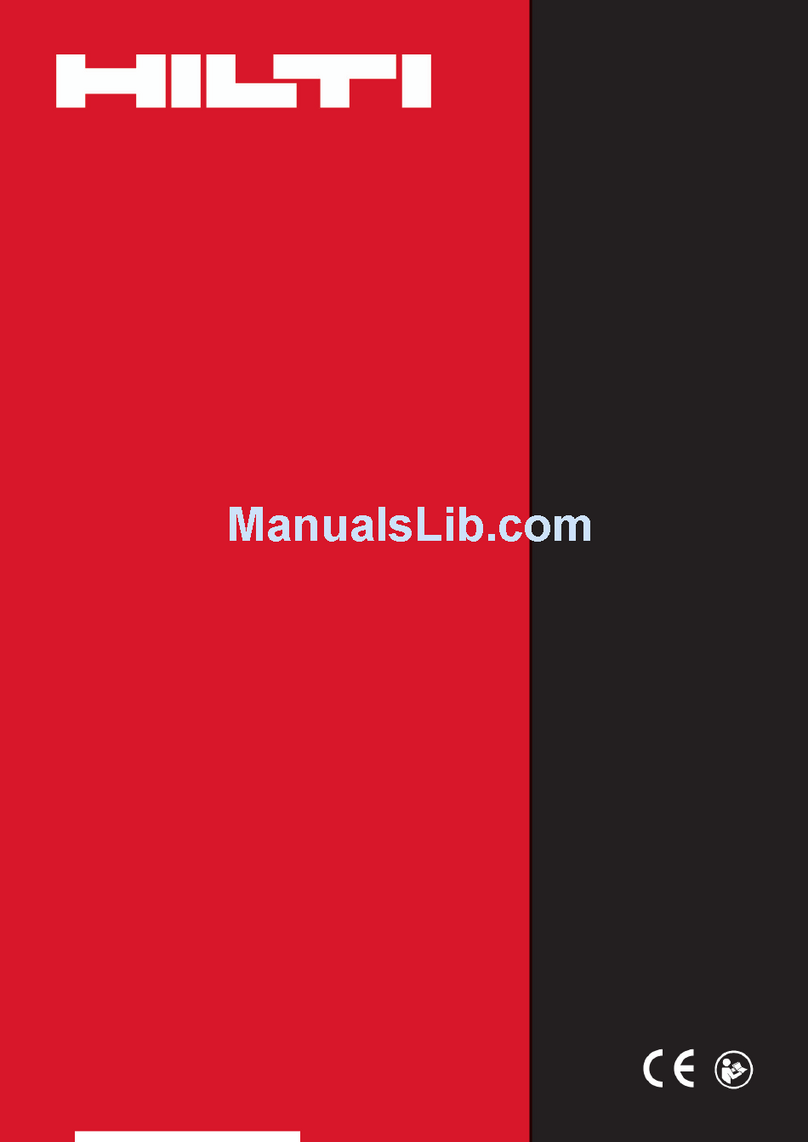
Hilti
Hilti SCW 22-A User manual
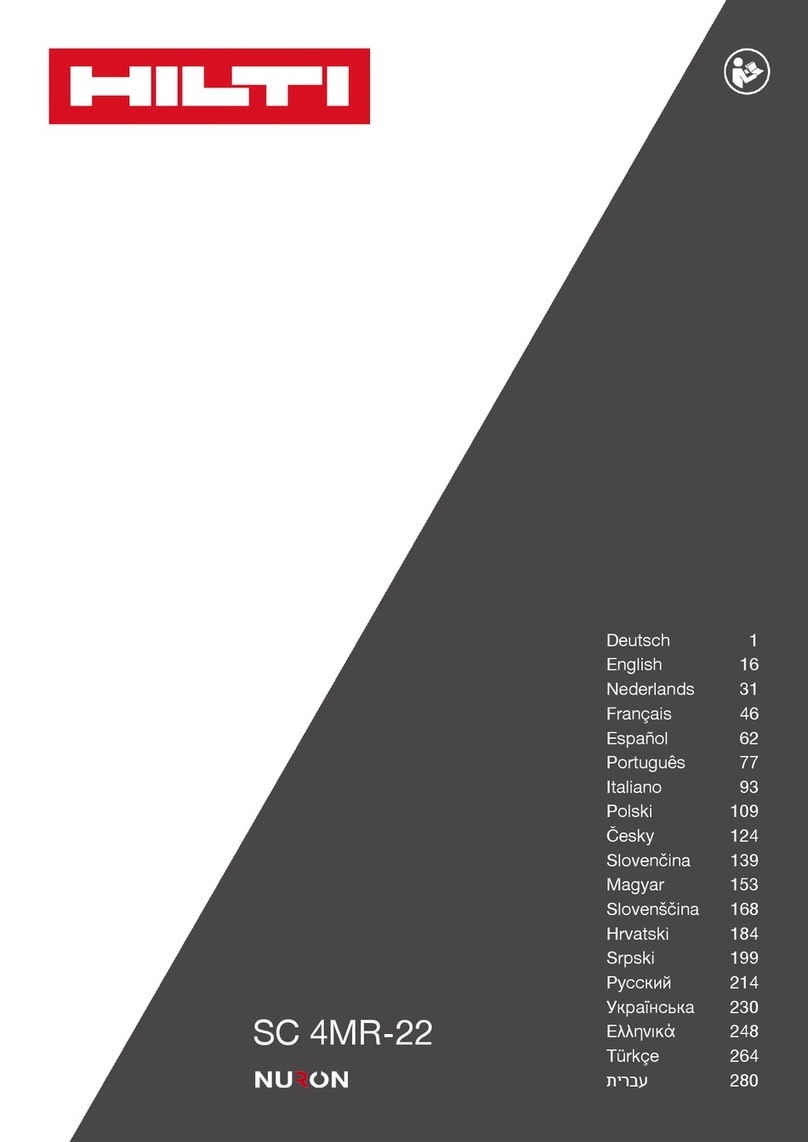
Hilti
Hilti Nuron SC 4MR-22 User manual

Hilti
Hilti WSC 85 User manual

Hilti
Hilti DSW 1510-CA User manual

Hilti
Hilti DSH 700-X User manual

Hilti
Hilti SCW 22-A User manual

Hilti
Hilti NURON SC 4WL-22 User manual

Hilti
Hilti NURON SB 4-22 User manual

Hilti
Hilti SR 30 User manual

Hilti
Hilti WSR 1000 User manual

Hilti
Hilti WSR 1000 User manual

Hilti
Hilti SCW 22-A User manual

Hilti
Hilti SB 4-A22 User manual

Hilti
Hilti NURON DSH 700-22 User manual

Hilti
Hilti SR 30 User manual
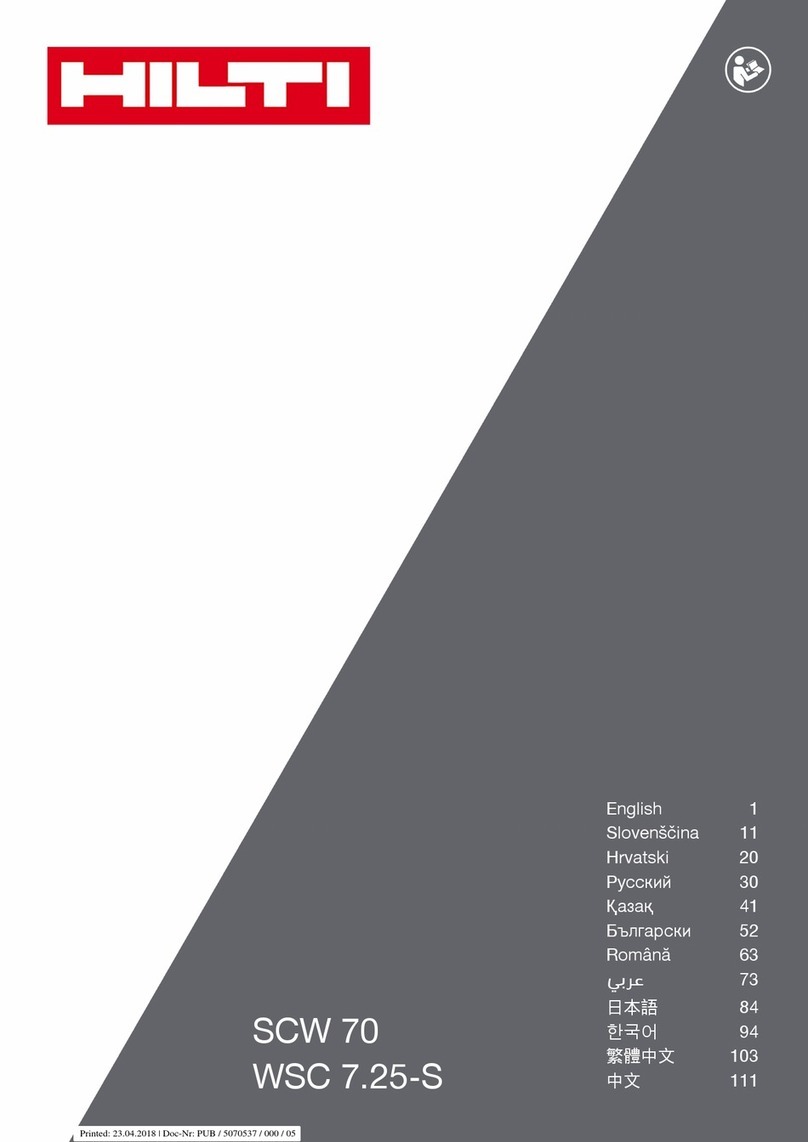
Hilti
Hilti SCW 70 User manual

Hilti
Hilti WSC 255 User manual

Hilti
Hilti WSC 85 User manual
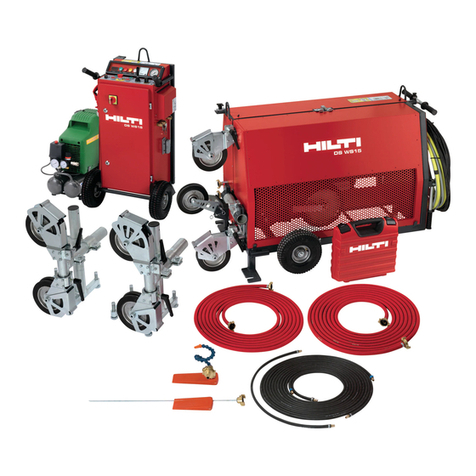
Hilti
Hilti DS WS15 User manual

Hilti
Hilti DSW 3018-E User manual
